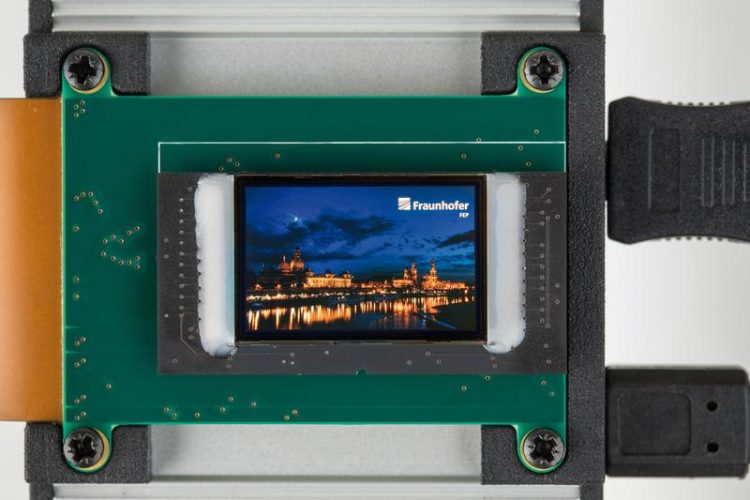Enjoying virtual-reality-entertainment without headache or motion sickness

1“ 120Hz WUXGA OLED microdisplay © Fraunhofer FEP
VR glasses are increasingly popular. Not only are computer fans enthusiastic about them, virtual tours through museums or exhibitions are possible, and prospective purchasers can 'see' the interior of their new car with various color and fabric choices.
However, currently available VR glasses are usually heavy and oversized, while the feeling of “being right in the scene” often changes to a feeling of being on the deck of a boat during heavy swell. This 'motion sickness' is caused partly by low frame rates and flickering of the images, and partly by an inappropriate field of view.
The latest research results from the European funded project LOMID (Large cost-effective OLED microdisplays and their applications) will solve these challenges: Large-area OLED microdisplays, combined with advanced free-form optics provide an ergonomic and lightweight solution for the design of VR glasses, and higher frame-rates will reduce the motion sickness for users.
As part of the project, scientists from Fraunhofer FEP have developed new OLED microdisplays with a size of one inch and a resolution of 1920 × 1200 pixels (WUXGA, 2300ppi) and framerates of 120Hz. Ultra-compact optics, designed by project partner LIMBAK, seamlessly combine two display chips per eye, making four in total for the entire headset. With two WUXGA microdisplays per eye, the headset has a total resolution of 4800 x 1920 pixels, which is close to 5k. This design facilitates very high effective display resolutions and a wide field of view (>100°) for an excellent immersive VR sensation.
Moreover, the optics scientists of LIMBAK have been able to decrease the display-to-eye distance needed in the headset, lowering it to only 37 mm (compared to 60-75 mm in most conventional headsets). This ultra-compact optical design reduces the headset size to about a quarter of the volume and half the weight of a conventional headset while maintaining the same field of view.
Judith Baumgarten, scientist in the IC and System Design department at Fraunhofer FEP explains the design approach taken to reach high framerates and thus reducing motion sickness effects and flickering in VR applications: “To offer such high framerates of 120 Hz and thus high data rates, we have extended the parallel interface of the OLED microdisplays.
The display mode can be configured flexible from hold-type to impulse-type. The latter allows the elimination of motion artefacts and flicker with a special rolling emission mode. The chip also provides special look-up-tables for gamma correction – each channel (red, green, blue, and white) can be calibrated individually. We achieved a superior image quality with a very high contrast ratio of >100'000 : 1 at extraordinary low power consumption. We are very pleased about these positive results of our displays in combination with the ultra-compact optic design of LIMBAK, which enable really compact VR devices.”
The tiling of multiple OLED-on-silicon microdisplays inside the system has helped to reduce its form factor and weight, while increasing resolution to a level not easily achieved by conventional TFT-based AMOLED displays in VR headsets currently due to their typical pixel density limits. This approach also supports keeping yield and thus costs in a reasonable range.
Latter fact of keeping the costs of manufacturing large-area OLED microdisplays in a reasonable range was one of the main goals within LOMID project. Therefore also the partner X-FAB developed economical processes at the CMOS silicon foundry, paying special attention to the interface between the top metal electrode of the CMOS backplane and the subsequent OLED layers. Further on partner Microoled S.A.S. is responsible for the fabrication of the whole OLED microdisplays – the key component for these kinds of VR glasses using those CMOS backplane wafers.
Scientists from Fraunhofer FEP will present a LOMID headset prototype as well as research results during the awe Europe 2018 at booth no. 322, from October 18-19, 2018 at MOC Exhibition Center Munich, Germany.
About the LOMID project:
The LOMID research project, running from January 2015 to June 2018, involves eight partners from five countries. Four of the partners are research institutions or universi¬ties: The Fraunhofer Institute for Organic Electronics, Electron Beam and Plasma Technology FEP has contributed to the microdisplay backplane IC design and prototyping; the University of Leipzig has synthesized materials for transparent oxide transistors; the University of Oxford has addressed vision aid applications; and the French Commissariat à l’énergie atomique et aux énergies alternative (CEA) Leti has developed techniques allowing the displays to be bent. The industrial partners are the X-FAB silicon foundry, respon¬sible for CMOS chip manufacture; MICROOLED, responsible for microdisplay manufacture and commercialisation; Limbak, responsible for the design of high-performance optics, and Amanuensis, supporting project management.
The LOMID project has received funding from the European Union’s Horizon 2020 Research and Innovation Programme under Grant Agreement No 644101. See also: www.lomid.eu
Fraunhofer FEP at awe europe 2018: exhibition booth no. 322
Press contact:
Ms. Annett Arnold
Fraunhofer Institute for Organic Electronics, Electron Beam and Plasma Technology FEP
Phone +49 351 2586 333 | presse@fep.fraunhofer.de
Winterbergstraße 28 | 01277 Dresden | Germany | www.fep.fraunhofer.de
Media Contact
All latest news from the category: Information Technology
Here you can find a summary of innovations in the fields of information and data processing and up-to-date developments on IT equipment and hardware.
This area covers topics such as IT services, IT architectures, IT management and telecommunications.
Newest articles

Properties of new materials for microchips
… can now be measured well. Reseachers of Delft University of Technology demonstrated measuring performance properties of ultrathin silicon membranes. Making ever smaller and more powerful chips requires new ultrathin…

Floating solar’s potential
… to support sustainable development by addressing climate, water, and energy goals holistically. A new study published this week in Nature Energy raises the potential for floating solar photovoltaics (FPV)…

Skyrmions move at record speeds
… a step towards the computing of the future. An international research team led by scientists from the CNRS1 has discovered that the magnetic nanobubbles2 known as skyrmions can be…





















